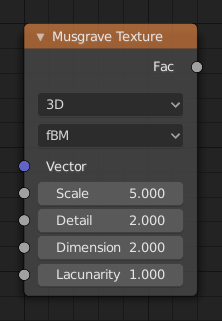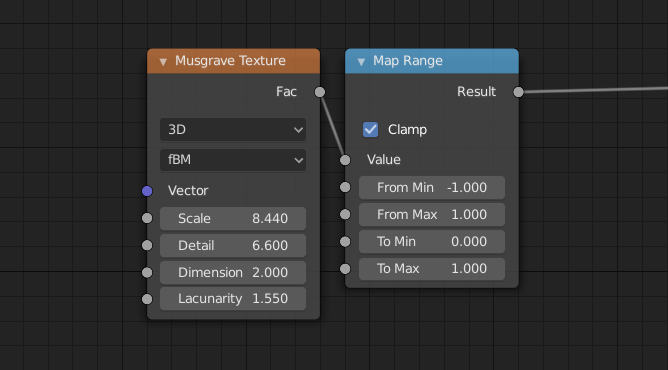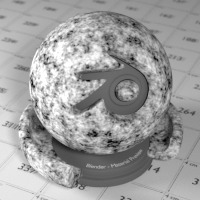Node Musgrave Texture¶

Node Musgrave Texture.
The Musgrave Texture node evaluates a fractal Perlin noise at the input texture coordinates. Unlike the Noise Texture, which is also a fractal Perlin noise, the Musgrave Texture allows greater control over how octaves are combined.
Entrées¶
The inputs are dynamic, they become available if needed depending on the node properties.
- Vector
- Texture coordinate to evaluate the noise at; defaults to Generated texture coordinates if the socket is left unconnected.
- W
- Texture coordinate to evaluate the noise at.
- Scale
- Scale of the base noise octave.
- Detail
- Number of noise octaves. The fractional part of the input is multiplied by the magnitude of the highest octave. Higher number of octaves corresponds to a higher render time.
- Dimension
- The difference between the magnitude of each two consecutive octaves. Larger values corresponds to smaller magnitudes for higher octaves.
- Lacunarity
- The difference between the scale of each two consecutive octaves. Larger values corresponds to larger scale for higher octaves.
- Offset
- An added offset to each octave, determines the level where the highest octave will appear.
- Gain
- An extra multiplier to tune the magnitude of octaves.
Propriétés¶
- Dimensions
The dimensions of the space to evaluate the noise in.
- 1D
- Evaluate the noise in 1D space at the input W.
- 2D
- Evaluate the noise in 2D space at the input Vector. The Z component is ignored.
- 3D
- Evaluate the noise in 3D space at the input Vector.
- 4D
- Evaluate the noise in 4D space at the input Vector and the input W as the fourth dimension.
Higher dimensions corresponds to higher render time, so lower dimensions should be used unless higher dimensions are necessary.
- Type
Type of the Musgrave texture.
- fBM (fractal Brownian Motion)
- Produit un résultat non naturel homogène et isotrope. Utilise une cascade additive, les valeurs sont simplement ajoutées ensemble.
- Multifractal
- Le résultat est plus irrégulier (varie avec la position), plus similaire à un terrain réel. Urilise une cascade multiplicative.
- Hybrid Multifractal
- Crée des pics et des vallées avec différentes valeurs de roughness, comme des montagnes réelles s’élevant de plaines planes. Combine la cascade additive à une cascade multiplicative.
- Ridged Multifractal
- Creates sharp peaks. Calculates the absolute value of the noise, creating « canyons », and then flips the surface upside down.
- Hetero Terrain (Heterogeneous Terrain)
- Similar to Hybrid Multifractal creates a heterogeneous terrain, but with the likeness of river channels.
Sorties¶
- Factor
- Texture value.






